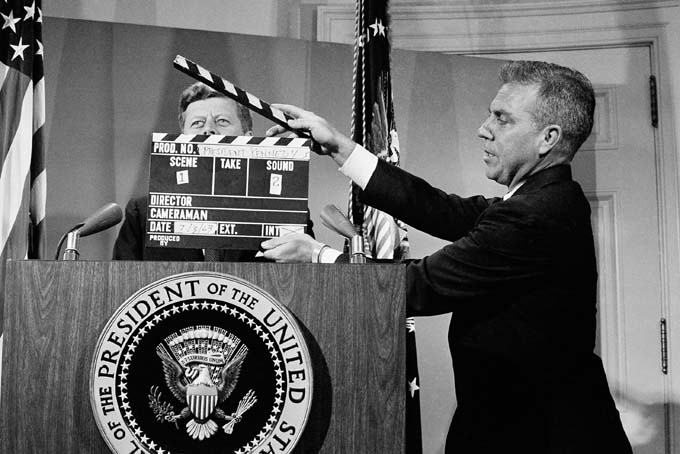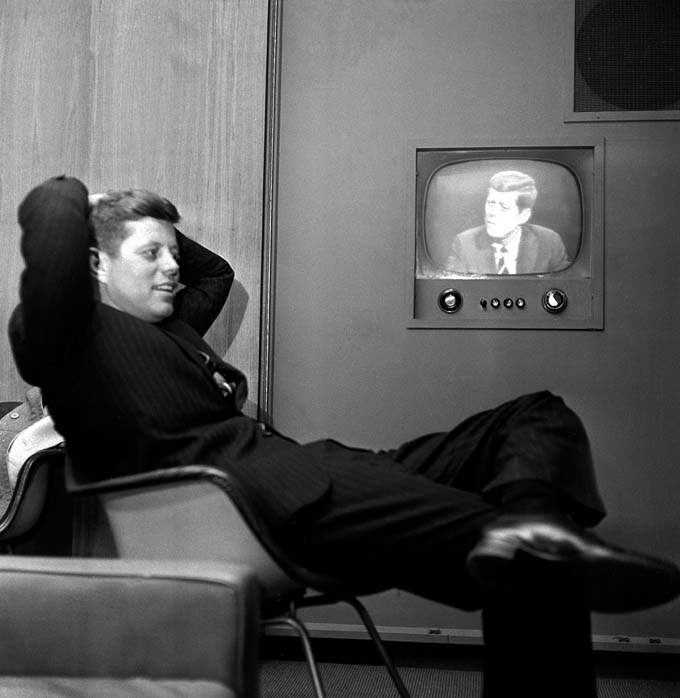
In this July 3, 1963 file photo, U.S. President John F. Kennedy stands at the lectern behind a production slate board during a television taping at the White House. (AP Photo)
by Frazier Moore
AP Television Writer
NEW YORK (AP) — It’s a measure of how long ago President John F. Kennedy died that, at the time, television was described as a young medium. With the shooting in Dallas, TV grew up.
Coverage that November weekend 50 years ago signaled, at last, that television could fulfill its grand promise. It could be “more than wires and lights in a box,” in the words of newsman Edward R. Murrow, and not just the “vast wasteland” that Federal Communications Commission chairman Newton Minow had branded it just two years before.

In this April 3, 1960 file photo, Sen. John F. Kennedy, Democratic presidential nominee, sits next to a playback of his televised appearance in Milwaukee, Wis. for the Wisconsin presidential primary two days later. (AP Photo)
Rising to an unprecedented challenge, television could perform an incalculable public service. It could hold the country together: Americans convened in a video vigil, gathering before an electronic hearth. Nonstop broadcasts by America’s three networks provided a sense of unity, a chance to grieve together, a startling closeness to distant events.
And television, exhaustively chronicling the murder, memorial and burial, gave viewers the final scenes of a political career ushered in almost in tandem with the video age.
In life and especially in death, John F. Kennedy changed television forever.
___
Back in 1956, TV in its infancy had introduced many Americans to the young politician as he made an unsuccessful bid for the Democratic vice presidential nomination.
Four years later, he was running for the presidency, with TV joining him on the campaign trail.
His landmark televised debates with Republican nominee Richard Nixon helped seal the deal. Some 70 million Americans watched the first debate, with the telegenic Kennedy deemed the clear winner. Televised debates would become staples of future presidential campaigns.
Once in office, Kennedy and the growing medium of television (households owning a TV had soared to 46.9 million in 1960 from 9.8 million a decade earlier, according to Nielsen) created further indelible images.
His inaugural address in 1961 was seen by millions as he urged Americans to “ask not what your country can do for you….” He charmed viewers with his televised press conferences, a first. They were candid, off-the-cuff and sometimes talk-show-host witty.
Once, a newsman asked Kennedy if, given the burdens of the presidency, he enjoyed the job — and would he recommend it to others?
“The answer to the first is yes, and the second is no,” he quipped, his face crinkled in a grin. “I don’t recommend it to others — at least, for a while.”
Viewers loved his wife, Jackie, too. In February 1962, all three networks — CBS, NBC and ABC — aired her tour of the newly restored White House. More than 80 million Americans tuned in.
“Television brought John Kennedy and his family into America’s living rooms as had been the case with no president before,” sums up historian Robert Caro, whose books include a multi-volume biography of Kennedy successor Lyndon Johnson.
Then, on Nov. 22, 1963, and in the days that followed, TV devoted itself to an all-consuming national tragedy.